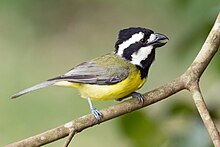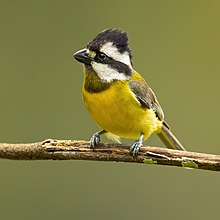Shriketit (original) (raw)
From Wikipedia, the free encyclopedia
(Redirected from Crested shriketit)
Species of bird
| Falcunculus | |
|---|---|
 |
|
| Eastern shriketit male | |
 |
|
| Eastern shriketit female | |
| Scientific classification |
|
| Domain: | Eukaryota |
| Kingdom: | Animalia |
| Phylum: | Chordata |
| Class: | Aves |
| Order: | Passeriformes |
| Family: | Falcunculidae |
| Genus: | FalcunculusVieillot, 1816 |
| Type species | |
| Lanius frontatus[1]Latham, 1801 | |
| Species | |
| See text |
The shriketits are a group of three species of birds in the genus Falcunculus endemic to Australia where they inhabit open eucalypt forest and woodland.
Taxonomy and distribution
[edit]
Three species are recognized, with disjunct ranges:[2][3]
- Northern shriketit (F. whitei), or White's shrike-tit - Campbell, AJ, 1910: Originally described as a separate species. It is found in the Kimberley region of north-western Australia and the Top End of the Northern Territory
- Western shriketit (F. leucogaster), or white-bellied shrike-tit - Gould, 1838: sparsely distributed in south-western Western Australia
- Eastern shriketit (F. frontatus) - (Latham, 1801): is in south-eastern Australia from the Lower South-East of South Australia, coastally and in the Murray-Darling Basin to south-eastern Queensland, with some scattered occurrences further north and west in Queensland
Males are larger than females in wing length, weight, and bill-size.[4] Males have black throats, while females have olive green throats, and both sexes have bold black and white markings on the face.[5]
Male eastern shriketit eating a caterpillar
They feed mainly on insects, spiders and, sometimes, particularly during the breeding season, young birds. Thistle seeds are also taken. They have a parrot-like bill, used for distinctive bark-stripping behaviour, which gains them access to invertebrates. The bird is unobtrusive, and the sound of the bark strips being torn off trees provides an indication of their presence. They nest high in a eucalyptus tree, in a fork of a branch, both sexes sharing the incubation and the rearing of the young. There may be two broods.[5]
- ^ "Falcunculidae". aviansystematics.org. The Trust for Avian Systematics. Retrieved 2023-07-16.
- ^ "IOC World Bird List 7.1". IOC World Bird List Datasets. doi:10.14344/ioc.ml.7.1.
- ^ Higgins, P. J.; Peter, J. M. (2002). Handbook of Australian, New Zealand and Antarctic Birds Volume 6: Pardalotes to Shrike-thrushes (1s published ed.). Melbourne: Oxford University Press. pp. 1050–1063. ISBN 0-19-553762-9.
- ^ Noske, Richard (2003). "Does the crested shrike‐tit Falcunculus frontatus exhibit extended parental care?". Corella. 27: 118–119.
- ^ a b "Crested shriketit". Birdlife Australia. Retrieved 5 July 2021.
- del Hoyo, Josep; Andrew Elliott; David Christie (2007). Handbook of the Birds of the World Picathartes to tits and chickadees. Lynx Communications. ISBN 978-84-96553-42-2.
- Dickinson, E. C. 2003. The Howard & Moore Complete Checklist of the Birds of the World. 3rd Ed. Princeton, N.J.: Princeton University Press,
- Schodde, R. and I. J. Mason. 1999. Directory of Australian Birds. Volume 1: Passerines. CSIRO Publishing, Canberra.
